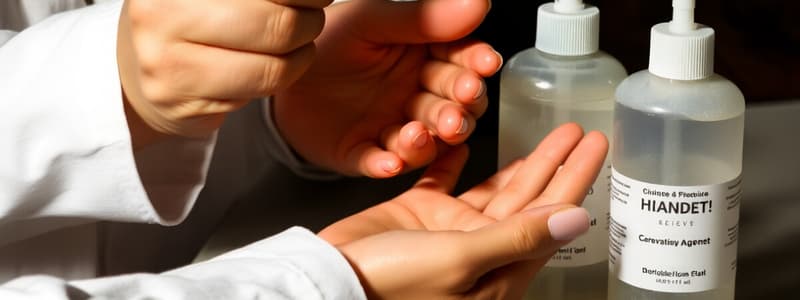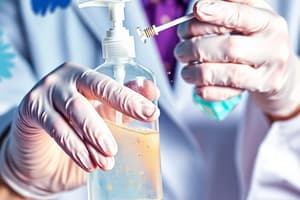Podcast
Questions and Answers
What is the primary purpose of microbiological growth media?
What is the primary purpose of microbiological growth media?
- To analyze genetic material of microbes
- To chemically define microbial structures
- To store microbial samples indefinitely
- To cultivate microbes (correct)
Which component is typically NOT included in undefined media?
Which component is typically NOT included in undefined media?
- Known chemical compounds (correct)
- Lipids
- Purines
- Amino acids
What is the term for media that contain ingredients with a known chemical structure?
What is the term for media that contain ingredients with a known chemical structure?
- Chemically defined media (correct)
- Undefined media
- Complex media
- Standardized media
In the preparation of growth media, which of the following is NOT typically provided by the instructor?
In the preparation of growth media, which of the following is NOT typically provided by the instructor?
Why are undefined media also referred to as complex media?
Why are undefined media also referred to as complex media?
What scale is used for evaluating the relative amount of microbial contamination?
What scale is used for evaluating the relative amount of microbial contamination?
Which type of observations should be recorded regarding the different organisms present?
Which type of observations should be recorded regarding the different organisms present?
What could be a potential factor influencing differences in microbial removal effectiveness among students?
What could be a potential factor influencing differences in microbial removal effectiveness among students?
If an agent is labeled as 'poor' in effectiveness, what can be inferred?
If an agent is labeled as 'poor' in effectiveness, what can be inferred?
What is a notable characteristic of the qualitative evaluation of contamination levels?
What is a notable characteristic of the qualitative evaluation of contamination levels?
In which part of the flame should inoculating instruments be sterilized?
In which part of the flame should inoculating instruments be sterilized?
What is the purpose of heat-fixing bacterial smears on slides?
What is the purpose of heat-fixing bacterial smears on slides?
Which media is generally used for growing large numbers of cells?
Which media is generally used for growing large numbers of cells?
What is the primary use of agar slants?
What is the primary use of agar slants?
What technique is used for transferring bacteria from one culture medium to another?
What technique is used for transferring bacteria from one culture medium to another?
Which of the following is an application of differential media?
Which of the following is an application of differential media?
What is the purpose of incinerating the mouths of open glassware items?
What is the purpose of incinerating the mouths of open glassware items?
Which type of culture is a streak plate primarily associated with?
Which type of culture is a streak plate primarily associated with?
What action is recommended to hold the inoculating loop correctly?
What action is recommended to hold the inoculating loop correctly?
Which of the following is NOT a form of media mentioned for microbial transfers?
Which of the following is NOT a form of media mentioned for microbial transfers?
Study Notes
Hand-Cleansing Agents
- Agents for hand-cleansing that necessitate only air-drying can be utilized on laboratory tables.
- Evaluation of contamination is based on a qualitative scale: +++ (heavy), ++ (moderate), + (light), 0 (none).
- Observations include diversity in microbial growth indicated by varying colors, shapes, and sizes.
Experiment Procedure
- Record results comparing microbial contamination before and after using different hand-washing agents.
- Each student should aim for consistency in evaluation while interpreting results regarding agent effectiveness (excellent, good, fair, poor).
- Key questions to consider include the most and least effective agents, persistence of microbes, and other contributing variables.
Microbiological Growth Media
- Culturing of microbes relies on complex growth media, made from undefined ingredients providing carbon and nitrogen.
- Nutrient Broth typically includes beef extract for growth.
- Chemically defined media contain known components in specific quantities, essential for controlled experiments.
Media Preparation
- Media are prepared through specific recipes and include nutrient broths and agar slants.
- The sterilization of inoculating instruments is crucial, with usage of different flame parts for proper heat-fixing.
- Aseptic techniques are emphasized to prevent contamination during microbial transfers (e.g., from culture tubes to sterile media).
Transfer Techniques
- Familiarity with inoculating techniques, such as using a loop like a pencil for optimal grip.
- Broths are used for cultivating microbes when fresh cultures or large cell numbers are needed.
- After inoculation, cultures must be incubated at a controlled temperature (around 35 ± 2 °C).
Equipment and Materials
- Essential lab materials include 2-liter and 500 mL Erlenmeyer flasks, stir bars, sterile Petri dishes, test tubes, and a balance for weighing ingredients.
- The use of a vortex mixer facilitates the suspension of bacteria in broth.
Evaluation and Practice
- Initial dexterity practice is recommended using sterile agar and broth to develop transfer skills before working with actual cultures.
- Peer evaluation helps improve technique and deepen understanding of microbial transfers.
- Maintaining a sterile environment and proper handling of cultures is vital throughout experiments.
Studying That Suits You
Use AI to generate personalized quizzes and flashcards to suit your learning preferences.
Related Documents
Description
This lab exercise focuses on the comparison of various hand-cleansing agents that require air-drying. Participants will observe and record the effectiveness of these agents in a structured table format. The results will help interpret the efficacy of different cleansing methods.




